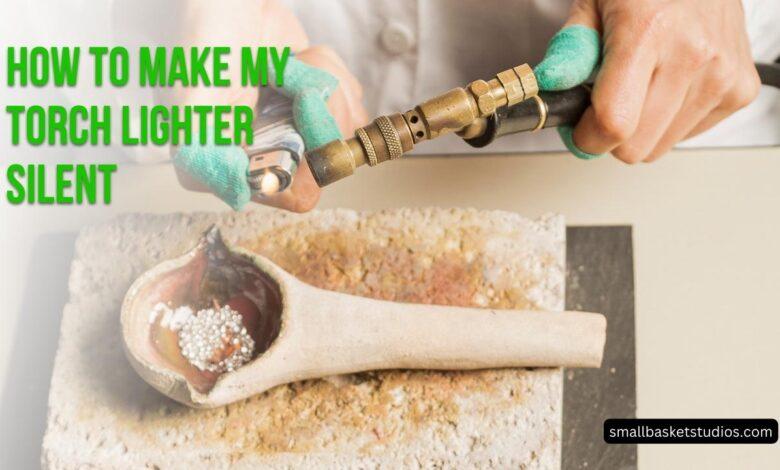How to Make My Torch Lighter Silent: A Professional Guide

In today’s world, where discretion and subtlety are often valued, the loud “whoosh” sound emitted by a torch lighter can be a jarring disruption. Whether you’re trying to enjoy a peaceful evening outdoors or simply want to maintain a low profile, a noisy lighter can be a nuisance. Fortunately, there are several effective ways to make your torch lighter silent, allowing you to light candles, fire pits, or cigars without drawing unwanted attention. In this comprehensive guide, we’ll explore various techniques to achieve a whisper-quiet torch lighter, ensuring a seamless and discreet experience.
Understanding the Anatomy of a Torch Lighter
Before delving into the methods of silencing your torch lighter, it’s essential to understand its basic anatomy. A typical torch lighter consists of a fuel chamber, a spark wheel mechanism, and a nozzle through which the fuel is expelled and ignited. The loud sound associated with torch lighters primarily stems from the rapid release of pressurized fuel through the nozzle, creating a distinctive “whoosh” noise.
The Importance of Proper Maintenance
Regular maintenance is crucial for ensuring your torch lighter operates optimally and with minimal noise. Over time, residue and debris can accumulate in the nozzle, restricting the fuel flow and causing increased noise during ignition. To prevent this, it’s recommended to periodically clean the nozzle with a soft brush or compressed air to remove any obstructions.
Adjusting the Fuel Flow
One of the most effective ways to reduce the noise produced by your torch lighter is to adjust the fuel flow. By regulating the amount of fuel expelled during ignition, you can significantly diminish the “whoosh” sound.
Adjusting the Fuel Adjustment Screw
Many torch lighters feature a fuel adjustment screw, typically located near the nozzle or on the body of the lighter. This screw allows you to control the amount of fuel released during ignition. To reduce noise, gently turn the screw counterclockwise to decrease the fuel flow. However, be cautious not to over-tighten or loosen the screw excessively, as this can impact the lighter’s performance or cause leaks.
Applying Gentle Pressure
If your torch lighter doesn’t have an adjustment screw, you can try applying gentle pressure to the fuel release lever or button while igniting. This technique can help restrict the fuel flow, resulting in a quieter operation. Experiment with different levels of pressure until you find the sweet spot that provides a consistent flame while minimizing noise.
Utilizing Noise-Dampening Materials
Another effective method for silencing your torch lighter involves incorporating noise-dampening materials. These materials can absorb or redirect the sound waves, significantly reducing the overall noise level.
Applying Silicone Sealant or Gasket Maker
One popular approach is to apply a small amount of silicone sealant or gasket maker around the nozzle area of your torch lighter. This creates a barrier that helps muffle the sound of the escaping fuel. However, exercise caution and avoid blocking the nozzle entirely, as this can compromise the lighter’s performance and potentially create safety hazards.
Using Flame-Resistant Insulation Materials
For a more permanent solution, you can consider wrapping the nozzle area with flame-resistant insulation materials, such as ceramic fiber insulation or high-temperature silica fabrics. These materials effectively absorb sound waves while withstanding the high temperatures generated during ignition.
Exploring Alternative Ignition Methods
If traditional torch lighters prove too noisy despite your efforts, you may want to explore alternative ignition methods that inherently produce less sound.
Electric Arc Lighters
Electric arc lighters, also known as plasma lighters, utilize an electrical current to create a brief, high-voltage arc across a small gap, igniting the fuel without the need for a conventional spark wheel mechanism. These lighters tend to be significantly quieter than their torch lighter counterparts, making them an excellent choice for discreet lighting needs.
Butane Lighters
While not completely silent, butane lighters can be a quieter alternative to torch lighters. These lighters rely on the controlled release of butane gas, which is then ignited by a spark, producing a relatively soft sound compared to the “whoosh” of a torch lighter.
Practicing Proper Technique
In addition to the aforementioned methods, your technique when igniting the torch lighter can also play a role in minimizing noise. Avoid abrupt or forceful movements when engaging the ignition mechanism, as these can contribute to increased sound levels. Instead, adopt a smooth and controlled motion to ensure a quieter operation.
Conclusion
Achieving a silent torch lighter is not only possible but also highly desirable for those who value discretion and subtlety. By implementing the techniques outlined in this guide, such as adjusting the fuel flow, incorporating noise-dampening materials, or exploring alternative ignition methods, you can significantly reduce the noise associated with your torch lighter. Remember, proper maintenance and a gentle technique are also crucial for ensuring optimal performance and minimizing unwanted sounds. With these strategies in hand, you can enjoy the convenience of a torch lighter without compromising on discretion or disturbing those around you.
FAQs
Will silencing my torch lighter affect its performance or fuel efficiency?
When done correctly, silencing techniques should not significantly impact the lighter’s performance or fuel efficiency. However, it’s essential to exercise caution and avoid over-restricting the fuel flow or blocking the nozzle entirely, as this can compromise the lighter’s functionality and potentially create safety hazards.
Can I use any type of silicone sealant or gasket maker to dampen the noise?
While silicone sealants and gasket makers can effectively muffle sound, it’s crucial to choose high-temperature-resistant varieties specifically designed for use with heat-generating devices. Regular silicone sealants may degrade or release harmful fumes when exposed to the lighter’s heat.
How often should I clean the nozzle of my torch lighter?
It’s recommended to clean the nozzle of your torch lighter every few months or whenever you notice a buildup of residue or debris. Regular cleaning helps maintain optimal fuel flow and prevents increased noise levels.
Are electric arc lighters completely silent?
While electric arc lighters are significantly quieter than traditional torch lighters, they may still produce a faint electrical buzzing or crackling sound during ignition. However, this sound is generally much more discreet than the “whoosh” of a torch lighter.
Can I use noise-dampening materials on a butane lighter?
Yes, you can apply noise-dampening materials, such as silicone sealant or insulation fabrics, to butane lighters as well. However, keep in mind that butane lighters are already relatively quiet compared to torch lighters, so the need for additional noise reduction may be minimal.




